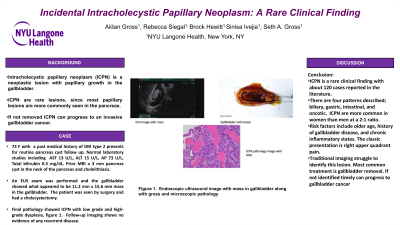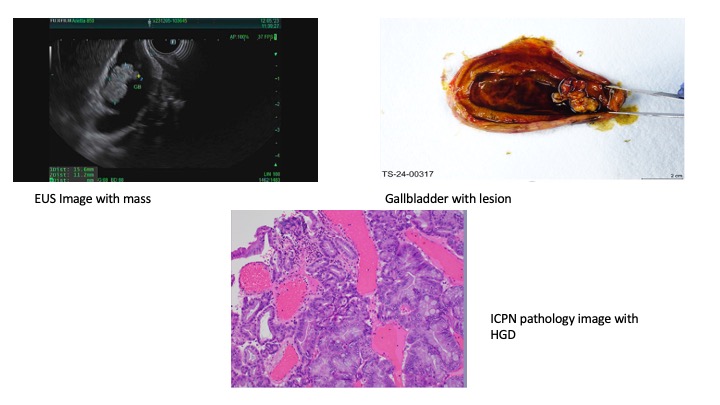Tuesday Poster Session
Category: Biliary/Pancreas
P3496 - Incidental Intracholecystic Papillary Neoplasm: A Rare Clinical Finding
Tuesday, October 29, 2024
10:30 AM - 4:00 PM ET
Location: Exhibit Hall E


Seth A. Gross, MD, FACG
Associate Professor of Medicine, NYU School of Medicine; Chief of Gastroenterology, Tisch Hospital
NYU Langone Health
New York, NY
Presenting Author(s)
Seth Gross, MD1, Aidan Gross, 2, Rebecca I. Siegel, 1, Brock Hewitt, MD1, Sinisa Ivelja, MD1
1NYU Langone Health, New York, NY; 2Chappaqua, NY
Introduction: Intracholecystic papillary neoplasm (ICPN) in gallbladder is a neoplastic lesion with papillary growth in the gallbladder. ICPN are rare lesions, since most papillary lesions are more commonly seen in the pancreas. If not removed ICPN can progress to an invasive gallbladder cancer.
Case Description/Methods: 73 F with significant past medical history of diabetes mellitus type 2 presents for routine pancreas cyst follow up. Clinically, patient without any gastrointestinal symptoms. Normal laboratory studies including AST 13 U/L, ALT 15 U/L, AP 73 U/L, Total bilirubin 0.5 mg/dL. MRI prior to endoscopic ultrasound (EUS) exam revealed a 3 mm pancreas cyst in the neck of the pancreas and cholelithiasis. An EUS exam was performed and the gallbladder showed what appeared to be 11.2 mm x 15.6 mm mass in the gallbladder. The patient was seen by surgery and had a cholecystectomy. Final pathology showed intracholecystic papillary neoplasm (ICPN) with low grade and high-grade dysplasia, figure 1. Follow-up imaging shows no evidence of any recurrent disease.
Discussion: Intracholecystic papillary neoplasm (ICPN) is a rare clinical finding with about 120 cases reported in the literature (1). There are four patterns described; biliary, gastric, intestinal, and oncotic. ICPN are more common in women than men at a 2:1 ratio. Risk factors include older age, history of gallbladder disease, and chronic inflammatory states. The classic presentation is right upper quadrant pain. Traditional imaging struggle to identify this lesion. Just like in our patient the abdominal MRI read only cholelithiasis. Most common treatment is gallbladder removal. If not identified timely can progress to gallbladder cancer. ICPN is a rare clinical entity, so it’s critical for clinicians to be aware of this gallbladder pathology.
References:
1. Arfan S, Sharma K, Anbazhagan L, Stear TJ. A Rare Finding of Incidental Intracholecystic Papillary Neoplasm Following Acute Cholecystitis Management. Cureus. 2023 Jun 30;15(6):e41222. doi: 10.7759/cureus.41222. PMID: 37525762; PMCID: PMC10387357.

Disclosures:
Seth Gross, MD1, Aidan Gross, 2, Rebecca I. Siegel, 1, Brock Hewitt, MD1, Sinisa Ivelja, MD1. P3496 - Incidental Intracholecystic Papillary Neoplasm: A Rare Clinical Finding, ACG 2024 Annual Scientific Meeting Abstracts. Philadelphia, PA: American College of Gastroenterology.
1NYU Langone Health, New York, NY; 2Chappaqua, NY
Introduction: Intracholecystic papillary neoplasm (ICPN) in gallbladder is a neoplastic lesion with papillary growth in the gallbladder. ICPN are rare lesions, since most papillary lesions are more commonly seen in the pancreas. If not removed ICPN can progress to an invasive gallbladder cancer.
Case Description/Methods: 73 F with significant past medical history of diabetes mellitus type 2 presents for routine pancreas cyst follow up. Clinically, patient without any gastrointestinal symptoms. Normal laboratory studies including AST 13 U/L, ALT 15 U/L, AP 73 U/L, Total bilirubin 0.5 mg/dL. MRI prior to endoscopic ultrasound (EUS) exam revealed a 3 mm pancreas cyst in the neck of the pancreas and cholelithiasis. An EUS exam was performed and the gallbladder showed what appeared to be 11.2 mm x 15.6 mm mass in the gallbladder. The patient was seen by surgery and had a cholecystectomy. Final pathology showed intracholecystic papillary neoplasm (ICPN) with low grade and high-grade dysplasia, figure 1. Follow-up imaging shows no evidence of any recurrent disease.
Discussion: Intracholecystic papillary neoplasm (ICPN) is a rare clinical finding with about 120 cases reported in the literature (1). There are four patterns described; biliary, gastric, intestinal, and oncotic. ICPN are more common in women than men at a 2:1 ratio. Risk factors include older age, history of gallbladder disease, and chronic inflammatory states. The classic presentation is right upper quadrant pain. Traditional imaging struggle to identify this lesion. Just like in our patient the abdominal MRI read only cholelithiasis. Most common treatment is gallbladder removal. If not identified timely can progress to gallbladder cancer. ICPN is a rare clinical entity, so it’s critical for clinicians to be aware of this gallbladder pathology.
References:
1. Arfan S, Sharma K, Anbazhagan L, Stear TJ. A Rare Finding of Incidental Intracholecystic Papillary Neoplasm Following Acute Cholecystitis Management. Cureus. 2023 Jun 30;15(6):e41222. doi: 10.7759/cureus.41222. PMID: 37525762; PMCID: PMC10387357.

Figure: Figure 1: EUS image along with macroscopic and microscopic images of ICPN
Disclosures:
Seth Gross: Cook – Consultant. Medtronic – Consultant. Microtech – Consultant. Olympis – Consultant. Provation – Consultant.
Aidan Gross indicated no relevant financial relationships.
Rebecca Siegel indicated no relevant financial relationships.
Brock Hewitt indicated no relevant financial relationships.
Sinisa Ivelja indicated no relevant financial relationships.
Seth Gross, MD1, Aidan Gross, 2, Rebecca I. Siegel, 1, Brock Hewitt, MD1, Sinisa Ivelja, MD1. P3496 - Incidental Intracholecystic Papillary Neoplasm: A Rare Clinical Finding, ACG 2024 Annual Scientific Meeting Abstracts. Philadelphia, PA: American College of Gastroenterology.
